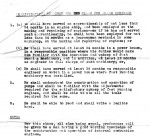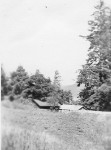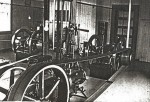Life on Kains Island 1933 – 1944
– Roy Carver (son of C. E. Carver on Kains Island November 1933 – July 1944)
Roy Carver told me he “was born at the Bancroft Nursing Home at 705 Cook Street in Victoria, BC in mid 1930s. This nursing home was set up for expectant mothers that lived in out of the way places with no doctors, like his mother Evelyn Carver. They could come to the home a month before the due date and stay a few days or a week before returning home.”

And Roy definitely did live in an out of the way place with his parents, and later his sister. His father was Clarence Edgar Carver who was the principal lightkeeper, fog alarm operator and radio beacon operator on Quatsino Lighthouse (aka Kains Island) during the period 1933 to 1944. Kains Island is located far up the western side of Vancouver Island on Quatsino sound. Nearest neighbours were six (6) miles (9.7 kilometers) away at the small fishing village of Winter Harbour.

He also said “My sister Joan was born in the mill hospital in Port Alice near the end of the 1930s. I’m told mother was taken to Port Alice and returned on a fish boat. The fishermen out of Winter Harbour were the most friendly and helpfull people you could ever want to know! I can relate stories about how they risked getting dumped into the sea and injury to get something important to us, or to remove a sick assistant, or us on our way down south on our holidays.”
According to Roy, his father C. E. Carver “was well qualified for the position of light keeper. He was one of the first Ham radio operators in Victoria, BC. His call sign was VE5EL in Victoria, and later on Kains Island VE5RN. He had also worked on the Empress cruise ships as a radio operator going to the Orient in the 1920s. His hobby was building radios of all types. Also he and his father built a couple of houses in the Victoria area. He was also very handy in fixing electric motors and gasoline engines. On nice days some times a fisherman would bring his boat and anchor off the island and father would row out and make the needed repairs and would receive a nice salmon or a few crabs for his trouble.”

I asked what his life was like at the time and he replied “We had no electricity except in dry cell batteries to run the radios. We had a pressure gasoline lamp (pump up with a fragile mantle) that hung on a hook in the middle of the ceiling of the living room at night and we would listen to the World War II news and the Lux Theater and Fibber Magee & Molly, and other shows on our large radio that stood on the floor which required a very long antenna strung between two poles out front of the main building.”
“We also had kerosene lamps that were carried around the house as needed. When I was small I would be tucked in upstairs at bed time with a kerosene lamp and later on likewise with my sister. We had kerosene lamps for outside use, similar to what the railroads used. Our bed rooms were facing south – that’s how I remember falling asleep during winter storms, hearing the rain and wind pounding on the side of the building and the small bedroom window during southeast storms.”

“On the main floor was a kitchen with a cast iron stove and a cast iron hand pump on the counter by the sink which pumped water up from the reservoir in the basement, which was filled with rain off the roofs. There was a living room, and a bed room (my parent’s) , also a small covered deck outside in front of the kitchen window, with a high wall around, mother would sit me in a high chair on the deck so she could keep an eye on me while she was making a meal. There was stairs that went up the east wall inside the building and made a right turn going up the south wall to the second floor.”
“On the second floor there was two bed rooms which I and my sister slept in. There was three large storage areas opposite the bedrooms where sacks of flour, sugar and other goods were kept. Between the bedrooms was the stairs to the next level, being the light house floor proper.”
“The only heat in the house was the cook stove in the kitchen. I can remember well when I was very young that when I was put to bed the load of blankets and a quilt was quite enough to keep me from falling out of bed, and we all wore heavy flannel pajamas.”

“The station lamp and it’s apparatus was housed in a glass (3/8″ thick) and steel building on top of the main building. The station lamp was kerosene. The lamp sat on a bowl that was floating in a slightly larger bowl with mercury so that the lamp was floating on mercury and level at all times. Around the outside edge of the smaller bowl with the lamp on it was a ring gear which was driven by a smaller gear powered through gears with a large spring that father wound up every night.”

“I can remember father being very fussy about the lamp wick being trimmed just right so as not to not smoke up the lamp glass. One could open a small steel door and climb outside the steel and glass building and walk around on a walkway with a steel railing and enjoy the view.”
“The basement I remember as being always damp and cold, a large portion of the basement was a reservoir – our water supply; the remaining area was used for storage of vegetables that we grew in the garden during the summer.”

At the back of the island there was a landing and a tramway up from the ocean. The winch was housed in a winch/warehouse building and “there was a vegetable garden on a flat area next to the warehouse. It was one of the only fairly level spot on the island large enough for a garden. ” This landing/warehouse area was over one-quarter (1/4) mile (400 metres) away from the main lighthouse building.
“The boat was kept on the landing platform and lowered and raised with the derrick fixed on the platform. The boat was only brought up the tram way from the landing for repairs, painting etc. The derrick mast was supported by cables to the rocks and a tree or two if I remember correctly. I would think that if one looked closely one could still see the eyebolts and steel works that kept the landing and derrick in place on the rock.”
“There was a lot of goods lost and people injured (almost drowned) below that landing over the years. All one had to do was miss-judge the in coming wave and a boat is smashed against the rocks dumping goods and men into the water. It was a very dangerous and scary place to land on the island at times. I often thought a diver would find some interesting stuff on the bottom below the landing. Father lost a large tool box full of mechanics tools one time, and fishing gear, even an outboard motor (a visitor) and of course numerous boats were damaged some beyond repair.”

“The sidewalks [to the warehouse] were three 2 X 12″s laid lengthwise. They could get very slippery during the winter rains. A few hand carts of coal went over the side over the years. The carts were made of oak (very heavy) with iron reinforcing and with iron wheels. The most difficult and dangerous work was wheeling the drums of gasoline, kerosene and lube oil to the engine building area where they were stored on racks horizontally with taps. All of our supplies were temporarily stored in the warehouse and the coal (for heating the house) was stored in bins in front of the warehouse and had to be moved to the main building.”
“I notice in some pictures that there are railings on the sidewalks now, and the sidewalks look wider. Nice! We never had railings except around the L-shaped area where the main building joined the engine/radio building. Father may have built those railings for I and my sister’s benefit as we used to play in that are and had strict orders to stay in that area!”
“On the kitchen side of the main building there was a door. Going through the door you would be in another building about the size of a small garage. Father built that building when I was very young as there was no place for my sister and I to play during the winter months. There was a swing and other toys for us to play with. Immediately upon going through the kitchen door, on your left and right, the were two doors; one facing the ocean, the other facing trees that were behind the main building.”
“The latter door was were one went through turned right and there was the one hole outhouse ! It was modern too. There was always last years Eaton’s and Woodward’s catalogs. I don’t know if toilet paper was expensive, hard to get, or what, but I don’t remember seeing much of it. Only when we went to the big city. Mother did the laundry in the building. The clothes line was just outside the door on the ocean side of the building; used in good weather, otherwise laundry was hung in the building.”

“There were two water-cooled Fairbanks Morse engines and two compressors in the engine building on Kains that I remember, used to operate the air powered fog horns. I don’t remember any other engines in the engine building. The exception was an engine in the warehouse to pull the tram to the warehouse from the landing. I’m pretty sure the one cylinder horizontal Fairbanks engines at Kains Island that powered the compressors used gasoline as fuel, as did a similar but smaller engine powering the winch used to pull the supplies up the track and into the warehouse from the landing.”
“The engines at Kains Island . . . were started by bringing the piston to the bottom of the intake stroke, with a gasoline filled oil can gasoline was put into a small brass bowl with a valve below that was screwed into the cylinder head. After the bowl was filled to a pre-determined level the valve was opened allowing the gasoline into the cylinder. The ignition (magneto) timing was retarded slightly. One would then hop up onto the flywheel rung, turning the flywheel and moving the piston over top dead center, then the brass valve was quickly closed and away the engine would go. Then the ignition timing would be advanced to it’s normal running position. The important thing was knowing when to hop off the flywheel. Any time that I saw the engines started it never seemed a problem to start them, they always started easily.”
“I remember the 45 gallon (205 liter) drums of gasoline had a red band around the middle of the drums, kerosene had a white band, and the lube oil had a blue band. I’m pretty sure there were more red drums around than the others. The drums were built much heavier than today and were galvanized on the outside.”
“When we moved to Active Pass Light Station (Mayne Island) there were similar engines doing the same job, except they were one cylinder vertical engines, also burning gasoline. These engines could be air started if there was air in the tanks. Not so for the engines at Kains island; not sure why.”
“If one looks closely at the larger picture of the lighthouse “Quatsino Lightstation c. 1930s” one can see the covered deck on the upper left side of the main building that faced more or less east. The building on the right, in line with the chimney was the building my father built. On the left it appears there is a door open on the engine building. Actually there were two doors that opened like barn doors and were usually left open when an engine was running, as the engines produced quite a bit of heat.”
“If one looks at the photo “Engine Room At Quatsino” one can clearly see one set of engine/compressor, and just to the left see the compressor of the second (spare) set, the two sets sat side by side. When I, and later my sister were old enough, one of our Saturday chores was to polish engine room brass! Father was very fussy about keeping things clean and organized everywhere; not only the engine room, so we learned the fine art of cleaning very early!
“The boat issued to the station was a very heavy constructed double-ended boat with heavy oak oars. No way anyone could row such a heavy boat safely anywhere around the island except during the calmest of weather without the danger of being swept out to sea. So of course father purchased an out board motor. It was a Johnson out board motor. Father had two or three over the years; very large, bulky, and awkward to carry as I remember. Father liked Johnson motors because he could connect a dry cell to the ignition system some how to make the engine start (rope pull!) easier, as they could be difficult to start some times. Especially if you were in a situation on the water that you needed the motor to start now!!”
“By the time I was old enough to remember anything, that boat in the photo was sitting beside the warehouse rotting, and a new, slightly shorter boat was issued. Same construction but with a transom. Father would take me and later my sister and I to Browning Inlet, a bay on the left side going to Winter Harbour, where we would catch crabs on the grassy bottom. I remember the beach was very shallow and if we landed on the beach and the tide was going out one had to continually keep the boat in the water as the tide went out or we would get stuck on the beach, as the boat was too heavy to move off the beach into the water.
“We often came home with three or four gunny sacks full of crabs. The next day or so, father and mother would cook the crabs in a large copper boiler, remove the meat from the shells and can the meat with a canning machine. During the summer there was lots of canning going on.”
“Father would go out fishing a few times every summer and in a few hours come home with a wheel barrow full of salmon all to be put in cans. A lot of the garden produce was also canned. I can remember my sister and I (bored!!) sitting in the back shed shelling peas and broad beans and cutting up string beans by the bucketfull, all to be canned. Carrots, parsnips, squash, pumpkins etc. were all kept in the cool basement.”
“The engine/radio building and the main building are joined in an L shape. On the ocean side of this area was a fence from the outside end of the engine/radio building (top of the L) to the outside corner of the main house (bottom end of the L) making a triangle area to play in. Beside this fence was one of two board walks from the main building to the engine/radio building. The other walkway was along the side of the main building passing the basement door. Every winter storms would damage the fence, more than once some winters; some winters only a few boards would go missing; sometimes the whole section would end up down on the rocks.”
“When I was born the doctors mentioned that a baby should have fresh milk after the nursing was over. So father and mother being good parents, brought a goat to the island thinking that goats eat most anything, require little care and that I would have fresh milk to drink. What they didn’t realize was that goats don’t come when they are called to be milked and they tend to like to climb over the rock cliffs where one can’t go and round it up whenever milk was needed. So the one goat milk farm was a bust! So it was back to Pacific condensed canned milk for me!
“It was a lot of work for my parents. Some times one reads a story by someone mentioning how nice and easy and romantic life must be on a light station. My parents never had time to be bored, that I remember!”
For additional information on Roy’s father, Clarence Edgar Carver, please see this page.